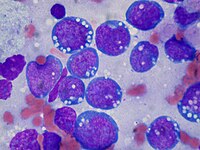
Photo from wikipedia
The impact of physical activity (PA) on lymphoma survival is not known. The association of PA and change in PA with overall (OS), lymphoma‐specific (LSS) and event‐free (EFS) survival was… Click to show full abstract
The impact of physical activity (PA) on lymphoma survival is not known. The association of PA and change in PA with overall (OS), lymphoma‐specific (LSS) and event‐free (EFS) survival was evaluated in a prospective cohort of newly diagnosed lymphoma patients (2002‐2012). We calculated Leisure Score Indexes (mLSI) from the self‐reported usual adult PA (baseline) and at 3‐years post‐diagnosis (FU3), grouping patients by active vs insufficiently active by the American Cancer Society PA guidelines. Associations of PA with survival were assessed using hazard ratios (HRs) and 95% confidence intervals (CI) from Cox models stratified by lymphoma subtype, adjusted for age, sex, baseline BMI, and comorbidity score with change scores further adjusted for baseline PA. Three thousand sixty participants were evaluable at baseline and 1371 at FU3. Active patients had superior survival from baseline [HR (CI): OS 0.82 (0.72‐0.94); LSS 0.74 (0.61‐0.90); EFS 0.92 (0.82‐1.02)] and FU3 [HR (CI): OS 0.64 (0.46‐0.88); LSS 0.32 (0.18‐0.59); EFS 0.82 (0.61‐1.10)] compared to insufficiently active. An increase in mLSI from baseline to FU3 (vs stable mLSI) was associated with superior OS (HR = 0.70, CI 0.49‐1.00) and LSS (HR = 0.49, CI 0.26‐0.94).The continuous change in mLSI at FU3 was significantly associated with OS, LSS and EFS; maintained across subgroups and appeared linear. Higher PA among lymphoma patients at diagnosis and 3 years is significantly associated with OS, LSS, and EFS. Increasing PA after diagnosis is significantly associated with improved OS and LSS supporting an important role for PA in lymphoma survivorship and the need for intervention trials.
Journal Title: American Journal of Hematology
Year Published: 2018
Link to full text (if available)
Share on Social Media: Sign Up to like & get
recommendations!